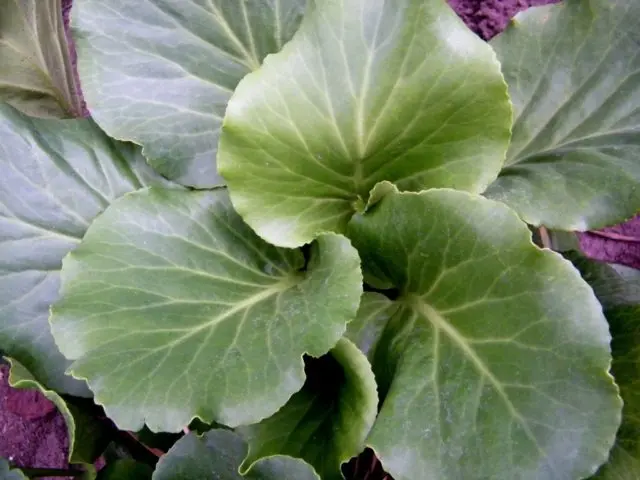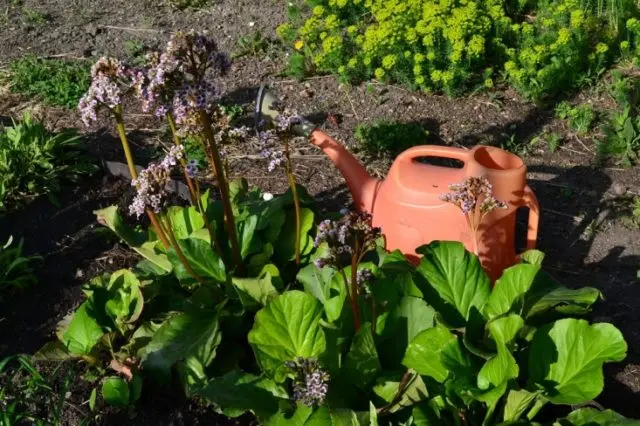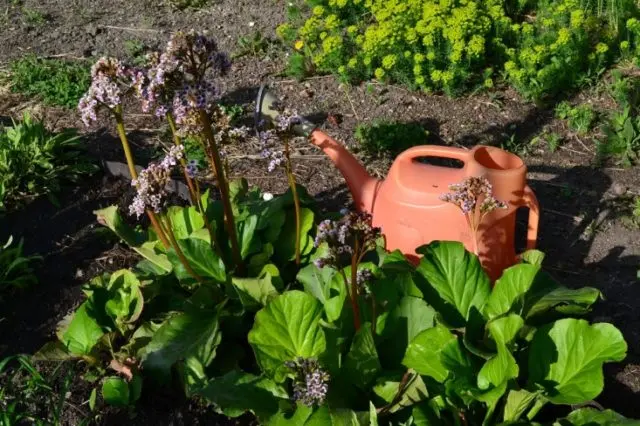Contents
Growing bergenia from seeds is the most common method of propagating the plant. This herbaceous evergreen perennial is unpretentious in care, quickly takes root in the garden. Serves as a decoration of sites, looks especially good against the background of stones and near water bodies. And its leaves have long been used to make tea drinks. Planting bergenia seeds is easy. It is enough to know the simple rules of agricultural technology.
How to grow bergenia from seeds
Sowing bergenia from seeds is carried out before winter. To do this, perform the following steps:
- take a landing container, fill it with ready-made soil;
- furrows are made at a distance of 3 cm from each other, their depth should be about 5 mm;
- the earth is watered with water slightly warmer than room temperature;
- seeds are laid out in the furrows, sprinkled;
- the landing capacity is taken out into the garden, dug in the snow.
Crops are brought indoors with the onset of spring. They are kept at a temperature of +18 degrees, in the shade.
The first sprouts of bergenia appear after 3 weeks. Take care of them like this:
- watered as the surface of the soil dries;
- loosen;
- plantings are thinned;
- the room where the badan is grown is regularly ventilated.
The next stage in the propagation of bergenia by seeds is picking. It is performed in May. This requires larger containers. There should be enough space so that the distance between the furrows is at least 15 cm, and between adjacent specimens – 5 cm or more.
Badan grown from seeds is planted in open ground in early August. Select areas of the garden with light, loose soils. Plants prefer partial shade, as the rhizomes directed horizontally and often protruding above the soil surface are afraid of overheating. Seedlings are planted like this:
- dig holes 6–8 cm deep;
- the bottoms are sprinkled with sand;
- bergenia is carefully rolled over with an earthen clod;
- sprinkle and water.

Badan, which was grown from seeds, begins to bloom in the third or fourth year after planting
Other methods of reproduction
In order for bergenia to retain its varietal characteristics, it must be propagated correctly. In addition to the seed method, there are others: dividing the bush and cuttings.
By dividing the bush
Badan propagation by dividing the bush is best done in autumn, in September. To do this, choose an adult plant. It is desirable that he was about 4-5 years old. A segment with a length of at least 10 cm is separated from the aerial part of the rhizome. At the same time, it is ensured that at least 3 living buds appear on it. The resulting material for reproduction is transferred to a new place, slightly deepened.
Cuttings
To propagate bergenia by cuttings, parts of rhizomes with young rosettes are cut from healthy, adult plants. This procedure is carried out in the spring so that the plant has enough time before the onset of cold weather to take root well and grow.

The cuttings are planted immediately in open ground, since the bergenia does not like frequent transplants.
To root the cuttings, do the following:
- soak the planting material in any root formation stimulator;
- holes are dug in the soil, the depth of which should be about 6–7 cm, and the distance between adjacent ones should be 50 cm;
- cuttings are placed in them, lightly sprinkled;
- watered abundantly;
- mulch.
Further care for bergenia cuttings is simple. It consists in weekly watering, loosening and cleaning the site of weeds, as well as fertilizing. For feeding in the spring, a potassium composition is added, and in the autumn months – superphosphate.
Care after breeding
Varieties of bergenia growing in nature have such qualities as unpretentiousness to living conditions, endurance and frost resistance. They were also transferred to decorative, garden varieties. Therefore, caring for bergenia is simple and requires elementary agrotechnical operations.
In early spring, dead and damaged foliage is removed from overwintered plants. Feed is applied under each bush. Preference is given to complex compositions. The purpose of their use is to stimulate growth and development, as well as prepare for flowering. When buds and flowers appear, plants require more nutrients.
The next fertilization is carried out during the period when the bergenia fades. This helps to replenish the supply of necessary substances and activate the growth of outlets.

Fertilizers can be applied simultaneously with watering, or this procedure can be carried out after moistening the soil.
Badan loves moisture, so it must be watered regularly. Particular attention is paid to water procedures in the following periods:
- during the formation of peduncles and blooming of buds;
- in dry, hot weather.
Most varieties bloom in spring, in April and May. After the flowers fade, the arrows must be cut with scissors. Leave them only in those cases when they plan to collect seeds.
In autumn, dead, old and damaged foliage is cut off. The flower tolerates frosts well, withstands temperatures down to -40 degrees, provided that it hibernates under snow. If there is no cover or it is too thin, then the rhizomes of bergenia should be covered with straw, spruce branches.
Tips
When propagated by dividing the bush or cuttings, or after transplantation, the badan may grow poorly for several years. Experienced gardeners in such situations are advised to check how deep the rhizome is, whether there are water stagnations on the site. If the roots do not lie too deep and do not rot due to excess moisture, then it is worth letting the plant take root in a new place. Badan may take some time to adapt.
If growth and development remain slow for more than 5 years, then it is better to transplant the plant to a new place. Badan does not like heavily shaded areas. It is better to give preference to light penumbra or even open, well-lit spaces.
Often, when sowing bergenia seeds and propagating in other ways, gardeners face such problems:
- Seeds do not germinate for a long time. In order to prevent such a situation, it is necessary to choose high-quality planting material, inspect it for damage, check the expiration date on seed packages.
- Bad, new roots are slowly formed. The rhizome is weakened. To avoid this, seedlings are soaked in root growth stimulants before planting.
Conclusion
Growing bergenia from seeds allows you to decorate the site with decorative at the same time unpretentious plantings. Plants look original not only during flowering. Their large foliage of beautiful shades adorns different parts of the garden.










So this is what AI writen articles look like. Funny but really sad.